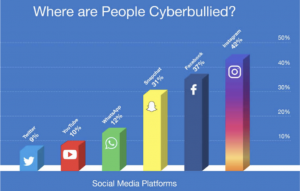Cyberbullying is on the Rise: What Can We Do to Stop It?
By Hilary Yamtich | July 19, 2019
Seventh grader Gabriella* (name changed) comes to school and reports to me, her teacher, that last night another student at the school sent mean messages on Snap Chat about her to other students and now her friends don’t want to sit with her at lunch. I reported this to administrators who were unable to identify the sender of the messages and did not follow up further.
Cyberbullying is on the rise and female students are three times more likely than male students to be bullied online. Data from the survey “Student Reports of Bullying: Results from the 2017 School Crime Supplement to the National Crime Victimization Survey,” says that 21% of female students and 7% of male students between ages 12 and 18 experienced some form of cyberbullying in 2017. Students in grades 9 through 11 are most likely to experience cyber- bullying. This data shows overall a 3.5% increase from the last year that this data was collected (2014-15.)
Of course this problem is getting worse; the increase is not just due to an increase in reporting—much younger students are gaining access to social media through smart phone apps. Students are more savvy about how to use social media. And students know that it is easy to maintain some degree of anonymity online by creating fake accounts to bully their peers. As in Gabriella’s case, administrators rarely have the time or tools to thoroughly address these incidents.
There are three main tools being used to address the problem.
First, lobbying groups such as Common Sense Education are pushing for legislation that criminalizes electronic bullying. In some states, cyberbullying can be prosecuted and even minor offenders can serve time for such offenses. Cyberbullying can also be a hate crime if certain language is involved. However, the vast majority of cyberbullying cases do not reach the level of actual legal prosecution.
Second, tech companies are also developing tools to address the issue. According to one study conducted by an anti-bullying organization Ditch the Label, the largest number of cyberbullying instances happen via Instagram. Instagram is using machine learning algorithms to identify potentially abusive comments and in 2017 unveiled a tool that allows users to block certain words or even entire groups of users.

Finally, many states have policies about how schools are meant to respond to cyberbullying incidents. For instance, in California the government provides an online training program for administrators to prevent and respond to online bullying.
Ultimately, the effectiveness of all these tools comes down to engaging with the young people who are involved. We can only address cyberbullying if we know that it is happening—this can come from young people understanding what is happening and feeling comfortable enough to tell an adult, or from machine learning tools that tech companies use to flag incidents. Obviously the technical solutions are limited by the extent to which tech companies are incentivized to catch acts of cyberbullying and the effectiveness of the tools themselves. And the likelihood that students will bring all incidents to adult attention is also not always high. Even when adults are made aware of these incidents, school officials might not have the technical knowledge or time to fully address the issues. Students are essentially on their own to deal with cyberbullying—without thorough education about their rights to be free of bullying online, many students simply accept the abuse and silently suffer.
Gabrielle spoke up about what was happening to her, but little could be done. The bullying did not rise to the level of hate crimes due to lack of specific language and administrators were not able to identify with certainty which students were involved. Gabriella became more withdrawn throughout the year and by the end of the year was in counseling for depression.

Educators especially in middle and high school need to implement the policy recommendations that already exist to ensure that these incidents are addressed effectively. Teachers need to be supported in taking time to educate students about these issues. And tech companies need to work more directly with parents and young people to ensure that the protections that they design are actually used effectively.
